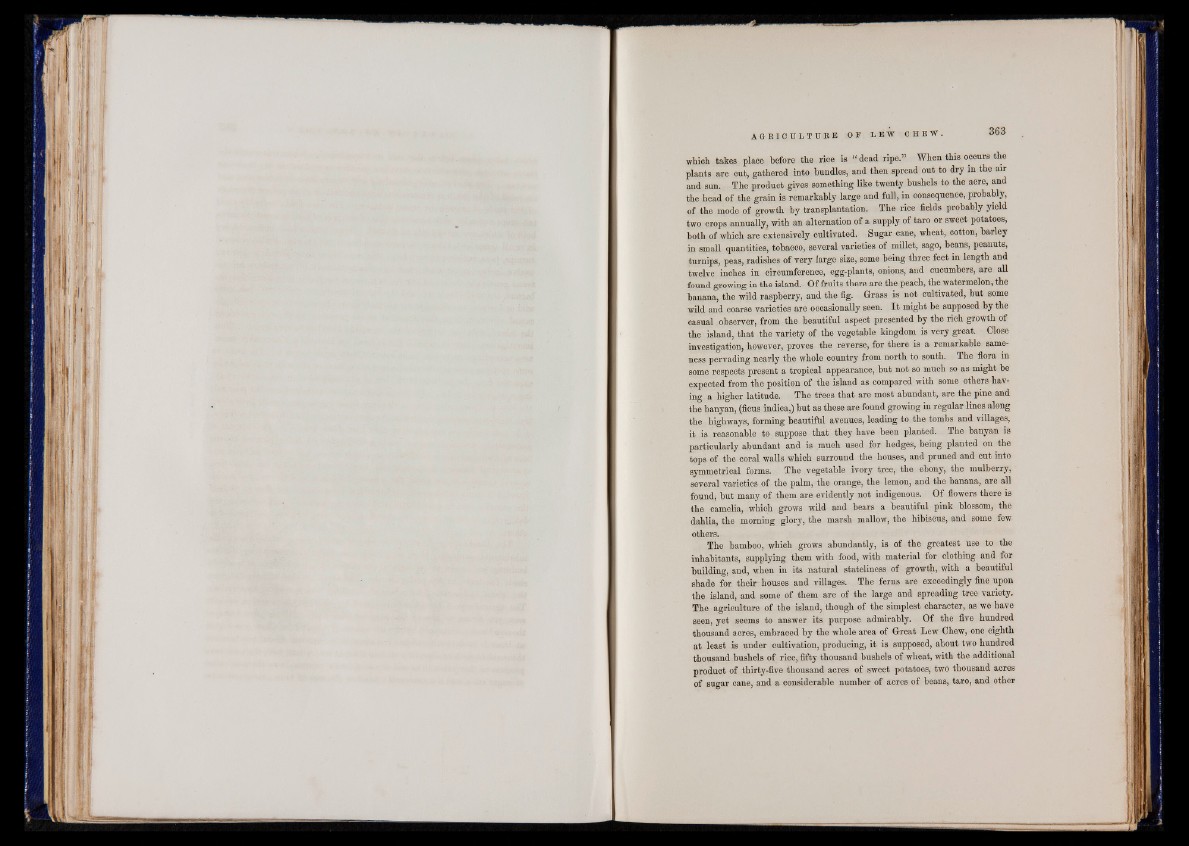
which takes place before the rice is “ dead ripe.” When this occurs the
plants are cut, gathered into bundles, and then spread out to dry m the air
and sun. The product gives something like twenty bushels to the acre, and
the head of the grain is remarkably large and full, in consequence, probably,
of the mode of growth by transplantation. The rice fields probably yield
two crops annually, with an alternation of a supply of taro or sweet potatoes,
both of which are extensively cultivated. Sugar cane, wheat, cotton, barley
in small quantities, tobacco, several varieties of millet, sago, beans, peanuts,
turnips, peas, radishes of very large size, some being three feet in length and
twelve inches in circumference, egg-plants, onions, and cucumbers, are all
found growing in the island. Of fruits there are the peach, the watermelon, the
banana, the wild raspberry, and the fig. Grass is not cultivated, but some
wild and coarse varieties are occasionally seen. I t might be supposed by the
casual observer, from the beautiful aspect presented by the rich growth of
the island, that the variety of the vegetable kingdom is very great. Close
investigation, however, proves the reverse, for there is a remarkable sameness
pervading nearly the whole country from north to south. The flora in
some respects present a tropical appearance, but not so much so as might be
expected from the position of the island as compared with some others having
a higher latitude. The trees that are most abundant, are the pine and
the banyan, (ficus indica,) but as these are found growing in regular lines along
the highways, forming beautiftil avenues, leading to the tombs and villages,
it is reasonable to suppose that they have been planted. The banyan is
particularly abundant and is much used for hedges, being planted on the
tops of the coral walls which surround the houses, and pruned and cut into
symmetrical forms. The vegetable ivory tree, the ebony, the mulberry,
several varieties of the palm, the orange, the lemon, and the banana, are all
found, but many of them arc evidently not indigenous. Of flowers there is
the camelia, which grows wild and bears a beautiful pink blossom, the
dahlia, the morning glory, the marsh mallow, the hibiscus, and some few
others.
The bamboo, which grows abundantly, is of the greatest use to the
inhabitants, supplying them with food, with material for clothing and for
building, and, when in its natural stateliness of growth, with a beautiful
shade for their houses and villages. The ferns are exceedingly fine upon
the island, and some of them are of the large and spreading tree variety.
The agriculture of the island, though of the simplest character, as we have
seen, yet seems to answer its purpose admirably. Of the five hundred
thousand acres, embraced by the whole area of Great Lew Chew, one eighth
at least is under cultivation, producing, it is supposed, about two hundred
thousand bushels of rice, fifty thousand bushels of wheat, with the additional
product of thirty-five thousand acres of sweet potatoes, two thousand acres
of sugar cane, and a considerable number of acres of beans, taro, and other